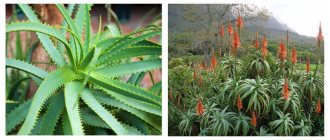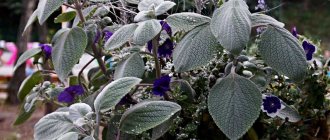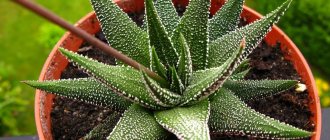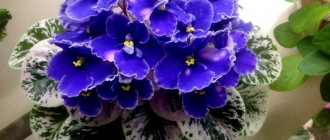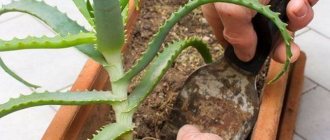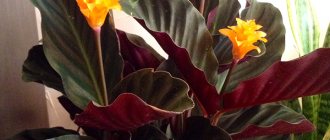A little about aloe
Aloe is a plant that grows both at home and in the wild. From this article you will learn what types there are, how to care for them, recipes for diseases and contraindications. It is important to know that the leaves also contain toxic substances, so you need to understand that you can only use the plant if you have complete information about it.
Aloe is a succulent plant of the Asphodelaceae family, which contains 400-500 species. They can reach a height of up to 10 meters and can also be small house plants. The plant has thick sword-shaped leaves and each leaf is equipped with thorns along the edges.
In nature, the leaves of the plant serve to accumulate moisture. The homeland of the species is Africa. There are many species that grow in Madagascar and the Arabian Peninsula. Life expectancy at home is from 5 to 20 years. All cultural species are perfect for landscaping an apartment.
Medicinal properties of aloe
The beneficial characteristics of aloe have been known since ancient times, so its medicinal composition has been well studied by many specialists. A high-quality effect can be obtained from leaves that are 3 years old. It is necessary to cut the leaf no shorter than 15 cm, and immediately it must be protected from light and placed in the refrigerator (stored for up to a year). Cut leaves lose their effectiveness within 3 hours.
According to experts, medicinal aloe has many positive characteristics:
- vitamin C – seals the walls of blood vessels, stimulates the immune system, improves tooth enamel, ensures elasticity of the skin;
- microelements and minerals – effectively cleanse the body of harmful waste and toxins, activate the metabolic process, relieve pain;
- vitamin A – stimulates fat metabolism, reduces cholesterol levels;
- catechin – has an antiallergic effect on the body;
- flavonoids – help disinfect the body and destroy harmful bacteria;
- organic acids – restore microflora in the digestive organs;
- tannins – have a bactericidal and anti-inflammatory effect;
- enzymes - slow down the aging process of the body, normalize the secretion of bile and adjust the functioning of the gastrointestinal tract.
Due to its excellent composition, the plant is actively used in cosmetology and medicine. In addition, it is grown at home and used in folk medicine. However, it is important to consult a doctor before use. Grow aloe properly and be healthy!
Chemical composition of leaves
This is a unique plant. It contains about 250 active biological substances. The plant has no equal among representatives of this flora. The main component of the leaves is water (97%).
Also, the leaves of this plant may contain:
- Esters
- Essential oils
- Phytoncides
- Flavonoids
- Tannins
- Beta carotene
- Anthraglycosides
- Anthraquinone
- Allantoin
- Polysaccharides
- Monosaccharides
- Amino acids: glycine, glutamic acid, etc.
- Vitamins: A, B1, B2, B3, B6, B9, C, E
- Simple organic acids (malic, citric, succinic, etc.)
- Microelements: selenium, calcium, potassium, magnesium, iron, phosphorus, manganese and others.
How to properly fertilize a houseplant?
At the moment, fertilizers are broadly divided into two types:
- Root feeding - should be watered directly under the root of the plant.
- Foliar feeding - the entire outer part of the flower (leaves, stem, etc.) is sprayed from a spray bottle.
For aloe, the first option is more suitable, since the second often leaves chemical burns on the leaves. Moreover, it is not even necessary to spray carefully and a little - the composition of foliar fertilizers itself is rarely suitable for aloe.
At home, it is best to feed aloe from May to August, when the fastest phase of plant growth begins. It is at this time that the aloe plant will best absorb the fertilizer it receives, and then immediately convert the resulting vitamins and minerals into growth and sap for the leaves.
The succulent needs to be fed no more than once every 1-2 weeks.
Many beginners mistakenly pour fertilizer onto dry soil. This is a mistake - watering should be done only after the soil is well moistened. If this is not done, the fertilizer may, on the contrary, harm the root system rather than deliver useful substances to it.
Almost all fertilizers include:
- ammonium nitrate;
- superphosphate;
- potassium salt and ammonium sulfate.
In addition, the following components remain very important for the plant:
- Nitrogen. It is responsible for the green color of the succulent, because nitrogen is involved in the production of chlorophyll. Due to the increased production of “green color”, the leaves acquire a healthy and strong appearance, and their growth is significantly accelerated.
- Phosphorus is needed for budding, color, root and leaf growth. If there is a lack of phosphorus in a plant, spots on the leaves, changing color, and slow growth can be observed.
- Potassium is needed mainly as a nitrogen conductor - without it, the circulation of nitrogen, carbon dioxide and oxygen production is extremely slow. We can say that it is potassium that converts carbon dioxide into oxygen. If it is absent from the plant, you can observe a characteristic white “edge” along the contour of the leaves, as well as a noticeable change in the color of the succulent.
- Magnesium is also important for photosynthesis. Without it, the rich green color of the succulent is lost and fades.
For flowering
The drug “Gilea” for cacti and succulents is very effective in achieving this goal. It is rich in nitrogen, potassium, phosphorus, magnesium and a number of other useful substances. You can feed it both before and during aloe flowering - in both cases, it has a positive effect on the rate of bud formation, their splendor, brightness and overall growth of the succulent.
Mode of application:
- Moisten the soil slightly with plain water.
- Take 1 liter of purified water (filtered or purchased sealed).
- Pour exactly 2 caps of Gilea into this liter.
- Mix everything thoroughly.
- Water the flower at the root.
In general, it is not recommended to use organic fertilizers, since the succulent digests them very poorly.
For fast growth
The general consensus among gardeners is that Bona Forte is ideal for promoting succulent growth. It is designed for cacti, but due to the proximity of these two types of plants, it also perfectly fertilizes aloe. The drug stimulates and strengthens plant growth, their immunity and healthy color. The composition contains as standard:
- magnesium, potassium, phosphorus, nitrogen, etc.;
- A distinctive feature is the addition of succinic acid to the composition.
Mode of application:
- Take 1.5 liters of clean water.
- Oh and add to the water.
- To stir thoroughly.
- Water at the root.
You can store the finished liquid, but no longer than three weeks from the date of production.
In the future, its shelf life will expire, and using the concentrate will be dangerous for the succulent.
Kinds
Plants are herbaceous, shrubby and tree-like. Of the many types, the most famous are:
Tree-like (Aloe arborescens)
Under natural conditions, this plant reaches a height of up to 3 meters. This particular plant is called agave. An evergreen succulent plant of the Asphodelaceae family. Its natural range covers South Africa: Mozambique, Zimbabwe, Swaziland and Malawi.
It has wide medical uses and is also cultivated as an ornamental houseplant. It was known as a medicinal plant back in Ancient Egypt, where, along with medicinal use, it was used in means for embalming the dead.
Spinous (Aloe aristata)
A perennial herbaceous succulent plant with thick, fleshy leaves collected in dense rosettes and arranged in a spiral. The diameter of the rosettes can reach 60 cm. The surface of the leaves is rough, with small white spots; edges with small spines. Grown as a houseplant.
Quiver (Aloe dichotoma)
This is a trembling tree or kokerboom. It reaches a height of up to 9 meters, the branched trunk reaches 1 m in circumference. Aloe quiver is a symbol of the south of Namibia. The quiver tree is also found in the desert regions of Angola.
Folded (Aloe plicatilis)
Woody or shrubby plant from the Asphodelaceae family. It is a small tree or shrub. Height 3-5 m. Stems forked. The leaves have an unusual shape: on the branches they are arranged in 2 rows like a fan, each of which has 10-16 leaves. Distributed in South Africa.
This is what aloe vera looks like at home
Variegated (Aloe variegata)
Aloe variegated, or tiger, is a perennial herbaceous succulent plant of the Asphodelaceae family. Distributed in South Africa and Namibia. The specific epithet variegata comes from the Latin, meaning "variegated" and refers to the plant as a mottled-leaved species.
The plant is 20-30 cm high, with 18-24 leaves arranged in 3 rows. The leaves are lush green in color, with uneven light green areas. The length of the leaves is 10-15 cm, the width at the base is about 3-6 cm. The shape of the leaves is triangular. Depending on injury, amount of water and age, the outer leaves will die off, turning a golden brown color.
Vera (Aloe vera)
Aloe vera, or Aloe Vera, is a succulent herbaceous plant of the Asphodelaceae. Widely used in medicine and cosmetics. In terms of chemical composition and medicinal use, this type of aloe is close to aloe vera.
This species has become established in the southern half of the Arabian Peninsula, in North Africa (Morocco, Mauritania, Egypt), as well as in Sudan, the Canary Islands, Cape Verde, and the island of Madeira. The plant grows wild in the Canary Islands. This plant can survive in conditions where others wither and die. In extreme situations, it closes the pores, trapping moisture inside the leaf.
Descoingsii (Aloe descoingsii)
Homeland - dry areas of Africa, Mascarene Islands, Madagascar and adjacent islands, in the south of the Arabian Peninsula. The smallest and most light-loving plant.
This herbaceous plant is distinguished by a shortened stem with leaves in the shape of an elongated triangle, collected in basal rosettes. During flowering, orange buds appear on a separate peduncle.
Frightening (Aloe ferox)
Aloe intimidating is one of the types of medicinal plants. It is distinguished by its external appearance, which is unusual for this shrub. Usually it grows tall, having a strong stem on which spiky, dense leaves are arranged in a checkerboard pattern. The intimidating appearance is a rosette of strong, long, fleshy leaves. The plant can reach 2 meters in height.
Overview of aloe species: varieties with photos and names
The healing properties of aloe are widely known - drinks, creams, and face masks are produced with it. It is used in medicine as an antiseptic and immunomodulator, and in cosmetology to deeply moisturize the skin. But as a houseplant it is even more exotic.
Some species have become well established on window sills; there is even a variety that is called homemade. But apart from one or two names, this succulent remains a stranger; I have seen it extremely rarely in apartments. Therefore, in this article I want to tell you more about the available varieties of aloe with photos and names.
Caring for tree Aloe, agave
This is a fairly hardy and unpretentious plant. Caring for agave is not at all difficult. It is enough to follow the basic rules of caring for this plant.
Illumination
The plant is light-loving, but it will not disappear even if it stands in the shade. In a dark space, aloe begins to stretch and its leaves turn white. In summer, it is better to take aloe to the balcony; such a plant grown in the fresh air will have stronger and better formed stems and spines. But you need to make sure that the aloe is not exposed to rain.
Watering
In summer, you need to water the agave every other day, but in winter it is rare (once a week) and with water at room temperature. The plant has thick roots that can take up the entire space of the pot, and therefore water quickly flows into the tray. In this case, it makes sense to pour water into the pan; the roots will absorb the water. An hour after watering, you can look into the pan and if there is water left, pour it out, otherwise the roots may rot.
Air humidity
Air humidity does not play a special role. But it is useful to periodically wipe the leaves with a damp cloth.
Top dressing
The plant needs to be fertilized once in spring and summer with a weak solution of mineral fertilizer. In autumn and winter, aloe is not fed.
Transfer
Young plants need to be replanted annually. Adult aloe plants are replanted every 2-3 years as needed. The pots must be deep and the pot must have drainage.
The soil
There are ready-made mixtures for aloe and other succulent plants. But it is advisable to add charcoal and brick chips to this mixture. If you decide to prepare the mixture yourself, then you can take turf soil, leaf soil, humus, sand and mix everything in the following proportion: 2:1:1:1. Add brick chips and charcoal. It is better not to add peat, because the soil reaction should be slightly acidic.
Reproduction
Propagating aloe is not difficult. You can do this with root shoots, apical and stem cuttings. You can also plant seeds. If you propagate by cuttings, you need to dry them for 1-2 days. You need to plant root shoots and cuttings in a substrate of sand and leaf soil 1:1, deepening them only 1 cm. You rarely need to water the cuttings, because there is enough moisture in the leaves, you only need to make sure that the substrate is slightly damp. As soon as the cuttings take root, watering should be increased slightly. This is done so that the plant begins to grow quickly.
Pests
Aloe is rarely affected by diseases and pests. But sometimes scale insects can settle on aloe. An ordinary soap solution will help get rid of these pests. You need to wipe the aloe leaves with this solution.
Home doctor
The medicinal properties of the aloe plant have been known since ancient times. Aloe vera (agave) and aloe vera have especially valuable properties. Their leaves contain medicinal juice, which is extracted using a press or this juice is collected manually from freshly cut leaves.
Based on aloe juice, many medicines and cosmetics have been created: gels, creams, skin balms, etc. In addition, aloe oil is widely used in medicine and cosmetics; it is also prepared from the leaves of this plant.
For treatment, you need to use only an old aloe plant, it must be at least 3 years old so that it can be used effectively as a medicine. It is advisable to cut leaves in autumn or winter. Before cutting the leaves, you should not water the aloe for about two weeks. In modern medicine, for recipes, it is recommended to use the juice from the leaves of the aloe tree.
Aloe has a positive effect on the following organs of the human body:
- Cardiovascular system;
- Gastrointestinal tract;
- Leather;
- The immune system;
- Nervous system;
- Eyes.
Aloe juice has a powerful bactericidal effect. Aloe juice is active against:
- Staphylococcus;
- Streptococci;
- Dysentery bacillus;
- Typhoid bacillus;
- Diphtheria bacillus.
Aloe Diseases and Pests
In this article we will not describe in detail all the problems in caring for succulents, we will only indicate the most common ones. In another article we will dwell on this issue in more detail.
Common Pests
- aphids,
- Scale insects,
- Spider mite,
- Weevils (adults and larvae),
- Whitefly,
- Various caterpillars.
Aloe Diseases
- Leaf spots (fungal infection)
- Fusarium oxysporum,
- Rust,
- powdery mildew,
- Stem rot (fungal infection),
- Root rot (fungal infection),
- Soft rot (bacterial rot), etc.
Problems in care
- dry leaves - sunburn (not to be confused with dying old leaves);
- curling leaves - stagnation of moisture or too much direct sunlight;
- leaves appear pale green in the center and the plant becomes elongated or leans to the side - too little light;
- Bursting or torn leaves mean the plant has received too much water in a short period.
But don’t be afraid of so many natural diseases and pests. A succulent grown in the optimal conditions described above will extremely rarely be subject to various misfortunes. But it’s still worth inspecting your plantings from time to time for problems or any abnormalities in growth and correcting them immediately.
What does aloe cure?
- Angina;
- Arthritis;
- Bronchitis;
- Hair loss;
- Gastritis;
- Herpes;
- Hypertension;
- Headache;
- Greasy hair;
- Constipation;
- Skin;
- Stroke;
- Exhaustion of the body;
- Cataract;
- Conjunctivitis;
- Mastopathy;
- Calluses;
- Wrinkles and sagging skin;
- Male impotence;
- Runny nose;
- Nosebleeds;
- Tumors;
- Low immunity;
- Cold;
- Dandruff;
- Gout;
- Bedsores, burns, frostbite;
- Pimples, blackheads;
- Digestion;
- Radiculitis, rheumatism;
- Stomach cancer;
- Stomatitis;
- Tonsillitis;
- Tuberculosis, pneumonia;
- Tired eyes;
- Furuncle;
- Chalazion;
- Stomach ulcer;
- Barley.
Reproduction
The process of propagating aloe is not difficult even for inexperienced gardeners. The plant takes root without problems and takes root from cuttings, regardless of the time of year.
Cuttings are lateral shoots that appear along the trunk of a plant.
- For propagation, side shoots are cut closer to the base and put in a dark place for 3-4 days to dry.
- After this, the cuttings are planted in a container filled with wet sand to a depth of no more than 1 cm. The distance between the cuttings is 5 cm. During the rooting period, the sand must be kept moist.
- After 1 - 2 weeks, the cuttings take root and are ready to be transplanted into small pots.
The soil should consist of a mixture of turf, leaf soil and sand.
Recipes
Sore throat, arthritis
- Combine 1 share of aloe juice, 2 shares of honey, 3 shares of vodka. Soak a towel in the resulting mixture and place it on the throat, then cover with parchment, cotton wool and tie it with a scarf. Keep the compress for 6 hours.
- Fill a half-liter glass jar halfway with crushed aloe leaves and add sugar. Sugar should be 1 cm above the leaves. We tie the neck of the jar with gauze and put it away from light for three days. After three days, take out the jar and add vodka to the top and leave for another 3 days. Then filter and squeeze out the remaining juice through cheesecloth. We drink the tincture three times a day, half an hour before meals, a tablespoon at a time, until health is completely restored.
- Take 30 g of aloe leaves, add 3/4 cup of water, beat with a mixer and leave for one hour. Boil the resulting mixture for 3 minutes and strain using gauze or a strainer. Gargle at least three times a day.
- Grind the aloe leaf, add sugar in 1:1 proportions. Leave in the dark for 3 days. Then fill the container to the brim with water and leave again for three days in the dark. The resulting mass is filtered and squeezed. We drink a tablespoon three times a day, half an hour before meals.
Bronchitis
1. Take a half-liter bottle of grape wine, pour it into 4 large aloe leaves and leave for 4 days. Take 1 dessert spoon three times a day.
2. You need to take 1 glass of finely chopped aloe leaves, 1300 g of linden honey, 1 glass of olive oil, 150 g of birch buds and 50 g of linden flowers. Before preparing the medicine, you need to wash the aloe leaves with boiled water and put them in the refrigerator in a dark place for 10 days.
Honey should be melted, crushed aloe leaves should be added to it. The resulting composition needs to be steamed, brew birch buds in 2 glasses of water and linden blossom, boil for 2 minutes. Strain, squeeze out the broth, pour into cooled honey and stir. Pour into 2 bottles, add olive oil to each equally. Store in the refrigerator. You need to take a tablespoon three times a day. Shake the mixture before use.
3. Combine warm honey, aloe juice and melted butter in 1:1 proportions. We consume it before meals four times a day in the amount of two teaspoons for five days. Then we take a break for five days.
Hair loss
If hair loss occurs, apply a compress of aloe juice for 1 hour.
Gastritis
1. Prepare a composition from 150 g of aloe juice, 250 grams of honey, one and a half glasses of Cahors wine. We insist in the dark for five days. Take 1 tablespoon half an hour before meals four times a day. 2. Grind the thick leaves of the plant, mix one hundred grams of crushed leaves and 100 g of honey. Take a teaspoon a quarter of an hour before meals three times a day. Treatment lasts three weeks. 3. Take the juice of the plant three times a day, two teaspoons 0.5 hours before meals. The period of admission is one or two months. 4. Aloe juice, preserved with alcohol, twice a day, only a teaspoon 0.5 hours before meals.
Herpes
1. Drink a teaspoon of aloe juice three times a day before meals. 2. Apply aloe juice to the area where the herpes rash occurs.
Hypertension
Take 3 drops of freshly squeezed aloe juice daily, diluting them (drops) in boiled water (teaspoon). Drink before meals. The blood pressure returns to normal by the end of 2 months.
Headache
Apply aloe pulp from a leaf cut in half to the temples. We take a horizontal position for half an hour in a room where there is twilight.
Greasy hair
3 hours before washing, you should rub aloe juice into the roots of your hair. This will strengthen your hair and help get rid of dandruff.
Constipation
1. We take freshly squeezed aloe juice for a whole month, 1 teaspoon three times a day before meals. 2. Composition: 0.1 kg. honey and 0.5 cups of plant juice (you need to take thick leaves, which have many healing properties) and leave for about 3 hours. Take a teaspoon three times a day for gastritis, chronic constipation, and excessive gas formation. 3. 0.15 kg. Grind the leaves of the plant by hand and pour in 0.3 kg. heated honey, but not boiled. Leave for a day, then reheat and strain. Take a dessert spoon in the morning an hour before meals.
Skin treatment
1. Aloe can be used for eczema, purulent wounds, burns, lupus, insect bites, cuts. You need to cut an aloe leaf and bandage the juicy side to the wound. 2. If skin diseases are chronic, it is recommended to take freshly squeezed aloe juice.
Stroke
Aloe juice with mumiyo will help restore health after a stroke, as they help resolve compactions and scars that form in the brain. Five grams of mumiyo are poured with three quarters of a glass of aloe juice.
The solution should be taken before meals twice a day, a teaspoon in the morning and shortly before bed. The duration of treatment is two weeks, the break lasts the same amount. During the break, you should take propolis tincture three times a day, 20–30 drops. Then continue treatment again. The treatment period should not exceed 2 months.
Exhaustion of the body
We cut off aloe leaves older than 3 years, put them in a dark and cool place (temperature 4–8°C) for 12–14 days. We take out the leaves, wash them, chop them, add water in proportions of 1:3, leave for 1 hour, squeeze out the juice. Take half a glass of juice, add 0.5 kg. peeled walnuts, 0.3 kg. honey, juice of three lemons. We drink the composition 0.5 hours before meals three times a day, a tablespoon.
Cataract
Mix aloe juice and honey in equal proportions. We wash our eyes with this mixture three times a day.
Conjunctivitis
Place the aloe pulp on the tip of a knife into a glass and pour very hot water into it. Wash your eyes with this infusion three to four times a day.
Mastopathy
Take aloe juice, corn oil, radish juice, 70% alcohol in equal parts. Mix everything and leave in the dark for one week. Take a tablespoon three times a day 20 minutes before meals. This remedy also resolves uterine tumors.
Calluses
Steam your feet. Cut the aloe leaf and cut it lengthwise. Apply the pulp to the callus, place polished paper on top and leave overnight. We make compresses several nights in a row. During the day, the callus should be lubricated with a nourishing cream.
Wrinkles and sagging skin
1. Remove the skin from a plant leaf and wipe your face with fresh pulp. Carry out the procedure every day.
2. Cut off the two bottom leaves of aloe, chop and add water (3/4 cup), stir and leave to infuse for a day. Pour the infusion into ice molds and freeze in the refrigerator. Wipe your face with ice cubes of aloe vera infusion.
3. Mix lanolin cream with aged aloe juice and vegetable oil in equal parts. The warm mixture is applied to damp skin (previously applied with a warm salt compress) with massaging movements of the forehead and neck. Remove the mask after a quarter of an hour with a spatula (or the handle of a spoon) and apply a protein mask on top (grind 2 tablespoons of protein with half a teaspoon of fine salt). The skin is cleansed with cotton wool soaked in sage or St. John's wort tincture after 10 minutes, then rinsed with the same infusion and lubricated with any liquid cream.
4. Take three large aloe leaves, chop them, pour a liter of chilled boiled water. Boil for five minutes over low heat, cool, strain. Should be stored in the refrigerator in a glass bottle. Lotion from the plant rejuvenates aging skin and acts as a wrinkle prevention.
5. If your facial skin is aging, then you should take one teaspoon of aloe juice, the same amount of vegetable oil and add to the mashed yolk. Young people are not recommended to use aloe to improve their skin.
Male impotence
Take equal parts of aloe juice, melted lard or goose fat, fresh unsalted butter, rose hip powder, and honey. Mix all ingredients well. Next, boil over low heat for five to seven minutes, cool and store only in a cool place. Dissolve a tablespoon of the drug in a glass of hot milk. Take three times a day half an hour before meals. Duration of treatment is at least 1 week.
Runny nose
1. Instill five drops of aloe juice into each nostril every three to four hours. 2. Take 4 parts of aloe juice, half the amount of pulp from the pulp of fresh rose hips, the same amount of honey mixed with lard in a 1:1 ratio, 1 part of eucalyptus oil. Mix everything well. Place tampons soaked in the mixture into each nostril alternately for fifteen minutes. We repeat the procedure several times a day. 3. Dilute the plant juice with boiled water in a ratio of 1:10 and drop it into the nose.
Nosebleeds
For frequent nosebleeds, twice a day for two weeks, you should eat a piece of aloe, no more than 2 cm long, twenty minutes before meals.
All types of tumors
We combine ten grams of aloe leaves, chaga leaves, and half a liter of wine. We insist for one week. Take a quarter glass three times a day.
Reduced immunity
1. Take freshly squeezed aloe juice 30 g, St. John's wort 20 g, honey 15 g, dry red wine three quarters of a glass and one and a half liters of water. Fill St. John's wort with water and cook for 5 minutes. Cool the broth and strain. Combine honey with aloe juice, pour it into the St. John's wort decoction, add wine. We pour everything into a dark glass bottle and leave it for a week. Take two teaspoons after meals three times a day for a month. 2. Place two tablespoons of honey at the bottom of a half-liter jar, add chopped aloe leaves to the shoulders of the jar and fill it all with vodka. Leave for 5 days and store on the bottom shelf in the refrigerator. Take a tablespoon half an hour before meals three times a day. Instead of vodka, you can use dry white wine.
Cold
Mix equal parts of vodka, aloe juice and honey thoroughly, take a tablespoon at a time. Store the mixture in the refrigerator.
Dandruff
We take medical alcohol and aloe juice in proportions of 1:4, stir and rub, moving the hair along the strand, into the scalp. The duration of treatment is for three months every other day. Store the solution in the refrigerator.
Gout
Chop five large cloves of garlic and half an onion. Cut off an aloe leaf, add a small piece (about the size of a quail egg) of beeswax and place everything in a saucepan. Add a tablespoon of melted butter. Bring the mixture to a boil over low heat, hold for another 1 minute, remove from heat and crush and mix everything. Next, cool and place overnight as a compress on the sore spot.
Bedsores, burns, frostbite
Take 100 g of aloe leaves, add half a glass of boiled water and mix in a mixer. Add half a glass of glycerin, a teaspoon of lemon juice to the mixture and mix again in the mixer. Let it sit for a day, then strain through cheesecloth into a dark glass bottle and place it on the bottom shelf in the refrigerator. For treatment, you need to fold a bandage in several layers, apply tincture to it and apply it to the sore spot for half an hour.
Pimples, blackheads
1. Wash aloe leaves, remove thorns and peel, and chop. Apply the resulting mixture to the skin of the face for a quarter of an hour. Then wash it off with warm water. 2. Masks made from aloe juice are useful for acne. We soak a napkin (10 layers of gauze) with freshly squeezed plant juice and leave it on the face for half an hour. You need to do such masks every day, if it improves - every other day, and then twice a week is enough. The treatment period includes 25 procedures. 3. Cleansing cream. Take 20 g of aloe juice, 20 g of honey, two egg yolks, sunflower oil - 10 ml, beeswax - 15 g. Melt the wax in a water bath and mix with oil. Add warm aloe juice, crushed mixture of yolks and honey to the resulting warm alloy in parts. When stirred, a creamy mass is formed. Apply to pimples or blackheads.
Poor digestion
Nine drops of freshly squeezed aloe juice three times a day.
Radiculitis, rheumatism
Mix 3 tablespoons of aloe juice and honey. Pour boiling water (a third of a glass), hold in a water bath for 5 minutes and cool slightly. Rub warm ointment into the sore spot, cover with plastic wrap and tie with a scarf. Apply compresses at night twice a week. The treatment period is at least a month.
Stomach cancer
1. Cut the leaves from a three-year-old aloe, place them in the refrigerator, chop them and squeeze out the juice. Pour boiling water (three tablespoons) over three fresh leaves of pink geranium and place in a hot water bath for 8 hours. We connect 2 tbsp. spoons of aloe juice, half a liter of cognac, geranium infusion and five percent iodine tincture (3 drops). We strictly observe proportions! Take a tablespoon before meals twice a day, morning and evening. There may be discomfort and pain, which will subside over time. 2. 1 kg. three-year-old aloe leaves need to be washed, dried, the thorns torn off from the sides, and crushed into pulp. Place in a glass jar and fill with May honey (0.5 kg) and strong red wine (1.2 l). Close the jar tightly and keep in the refrigerator for 5 days. For the first 6 days, take a teaspoon a day an hour before meals, and then a tablespoon twice a day. The treatment period is up to one and a half months.
Stomatitis
We cut off an aloe leaf, wash, chew or rinse the mouth with freshly squeezed aloe juice.
Chronic tonsillitis
1. Squeeze the juice into a plate from an aloe leaf that has been growing for at least two years. We drink a teaspoon of juice in the morning before meals. Treatment lasts 10 days. Then we take a break for one month. If symptoms recur, we carry out another course of treatment. 2. Lubricate the palatine tonsils every day with aloe juice combined with natural honey in proportions of 1:3 for two weeks. Every other day for the next 2 weeks. We carry out the procedure on an empty stomach.
Tuberculosis, chronic pneumonia 1
1. Mix 15 g of fresh aloe juice and 100 g of lard (goose fat can be used), butter, honey and cocoa powder and keep in the dark. Stir a tablespoon of this medicine in hot milk (1 glass). For tuberculosis we take it twice a day. You can add 10 g of mantle juice to the composition.
2. Grind a third of a kilogram of aloe leaves, mix with honey (250 g), add three-quarters of a glass of water, put on low heat for one and a half to two hours. Leave the broth to cool, then put it in a cool place for 24 hours. Take a tablespoon of the mixture once a day.
3. From the cut leaves of a three-year-old plant, make a green paste of one glass. We do not water the plant from which we will cut leaves for about a week. Place the prepared leaves in the refrigerator for a week. Mix one glass of leaves (gruel) with linden honey (1.2 kg), put on fire and bring to a boil. Take dried linden flowers (50 g), pour boiling water (1 glass) and boil for 2 minutes. We also pour boiling water (1 glass) over birch buds (150 g) and boil for 2 minutes. Cool the resulting decoctions, squeeze, strain, add aloe, honey and half a glass of olive oil. Take a tablespoon three times a day. Don't forget to shake before taking.
4. Take a glass of aloe juice, Cahors wine (can be replaced with something similar), honey, one tablespoon of birch buds, mix and leave for 9 days. Take a tablespoon of the mixture three times a day.
Tuberculosis, chronic pneumonia 2
5. Take half a glass of aloe juice, melted cow butter (1.5 kg), mumiyo (25 g), ground propolis (50 g), honey (250 g), pine resin (25 g). Mix and cool. Let it infuse for 5-6 days and take a tablespoon three times a day.
6. Take crushed aloe leaves (150 g), rendered lard (0.5 kg), cognac (1/2 cup), garlic (25 g), birch buds (50 g), honey (50 g .), white shells from 8 eggs (grind the shells into powder) and mix everything. Keep it out of reach of light for 5 days, remembering to stir. Take a tablespoon of the mixture once a day half an hour before meals.
7. Take 3-5 year old aloe leaves and put them in the refrigerator (temperature 4–8°C) in the dark for 2 weeks. After washing the leaves, chop them and add boiled water. Leave for one and a half hours. Squeeze out the resulting juice. Mix half a glass of aloe juice with chopped walnuts (500 g) and add 300 g of honey. Take a tablespoon with a glass of hot milk in the morning, at lunch and in the evening half an hour before meals.
8. Grind the two bottom leaves of a 3-year-old aloe, add three teaspoons of honey and a glass of water. Cook the mixture for 2 hours over low heat. Strain the cooled mixture. We take a decoction for pneumonia, a tablespoon three times a day, half an hour before meals. Treatment is one and a half months.
Tired eyes
Mix aloe juice and boiled water in equal parts. We wash our eyes.
Furuncle
Mix any vegetable oil (preferably olive) and aloe juice in equal proportions. We wet a gauze pad, apply it to the boil and fix it for 1 day. We change the napkin before going to bed every day. We are undergoing treatment for at least a week.
Chalazion
Place pure (not diluted) aloe juice daily into the eye that hurts, 3-4 drops 4-5 times a day and massage a little. Feeling better after a month and a half.
Stomach and duodenal ulcers
1. Cut the spines from the leaves, wash and chop. Mix half a glass of green gruel with honey (1 glass) or sugar and leave in the dark for 3 days. Add a glass of red grape wine and let it sit for another day. We drink a tablespoon of tincture 4 times a day, and 3 times a day we drink another 8-9 drops of aloe juice.
2. Mix Cahors wine, aloe, beet, cabbage, radish juice in 1:1 proportions. Simmer the mixture in the oven for about six hours. For stomach ulcers, drink three tablespoons in the morning, at lunch and in the evening half an hour before meals.
3. For stomach ulcers and chronic gastritis, drink aloe juice in the morning, at lunch and in the evening, 0.5 tablespoon half an hour before meals to increase immunity to infectious diseases.
4. Combine crushed half a glass of aloe leaves with a glass of sugar and wine, leave for one day. Strain, use 2 or 3 times a day before meals, a tablespoon for 1 or 2 months.
Barley
1. Pour cooled boiled water over the washed and crushed aloe leaf. Leave for 5-6 hours, strain. We apply compresses to the eyes.
2. Pour one part of aloe leaves crushed in a meat grinder (for example, 2 leaves) with 10 parts of cooled boiled water. Leave for 6–8 hours, strain. We wash the eyes and use them for compresses until the stye goes away.
It should be remembered that the greatest benefit will come if you use only fresh juice or pulp from this plant, so you need to remove it immediately before use.
Within a few hours, many active compounds begin to disintegrate. The pulp and juice from the leaves cannot be stored for a long time, even in the refrigerator. Of course, they will not deteriorate in the refrigerator, but they will lose many of their beneficial properties.
Growing conditions for indoor aloe
It is no coincidence that the legendary aloe is considered one of the hardiest plants. They can remain decorative in almost any conditions, if we do not forget about the heat-loving nature and origin of the species. Absolutely any premises with normal living conditions are suitable for these persistent succulents, and aloe can even adapt to different lighting conditions much better than cacti and co.
Lighting and placement
Aloe species differ in their light-loving nature, but all of them, without exception, can grow well both on a sunny windowsill and in a bright place with diffused lighting. It is believed that aloe plants tolerate direct sunlight well. But plants need to be adapted to the sun gradually, and in varietal plants or species with original colors, too intense lighting can cause changes, redness, and thinning of the leaves.
It is better to protect plants from the midday sun. Only one species tolerates shading - tree aloe. Usually aloe itself signals a lack of lighting by stretching and deforming the leaves, changing color to a paler one.
Despite the unpretentiousness of aloe, in winter it is sometimes difficult for it to adapt to short daylight hours. If possible, especially during a warm winter, the aloe should be moved to a more illuminated place or provided with additional lighting. When wintering in cool conditions, there is no need to adjust the lighting.
For aloe, the best place has always been considered eastern and western window sills or a place near southern windows.
Temperature and ventilation
Aloe belongs to heat-loving plants and is content with room temperatures during the period of active development; it is not afraid of heat and does not require artificial stabilization of temperatures.
During the dormant period, temperatures are only important if you want the aloe to bloom. It can only be stimulated by wintering at a temperature of at least 12 to 16 degrees, with a possible decrease to 5-10 degrees. If flowers are not the goal, aloe feels great in normal indoor conditions, but is more capricious in terms of lighting.
Aloe loves ventilation and access to fresh air. At the same time, drafts are most often not a problem for it and the plant tolerates even sudden temperature changes. This is one of the indoor plants that are not afraid of heating devices and air conditioners nearby, but it is better not to overdo it with too much overheating of the air. In summer, all types of aloe can be taken out into the open air, but with mandatory protection from precipitation.
Aloe dichotomous (Aloe dichotoma). © alloe

